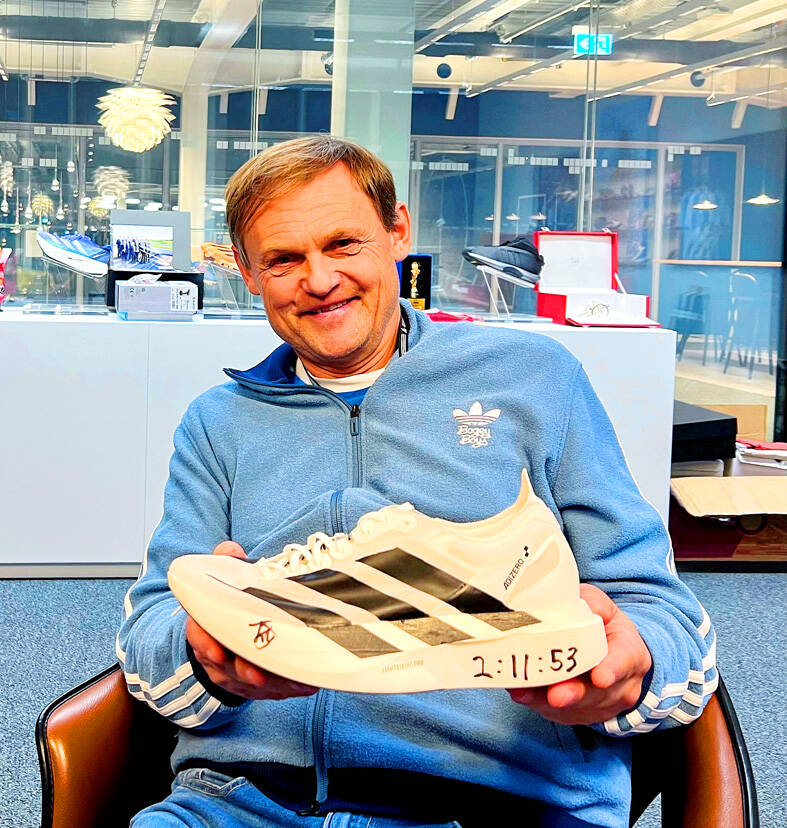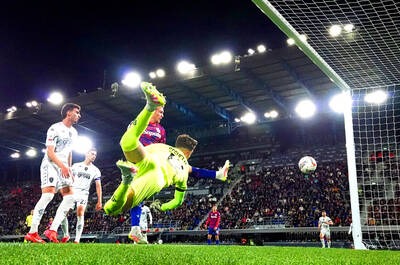A century after the 1924 Paris Olympic men’s marathon was won by Finn Albin Stenroos in 2 hours, 41.22 minutes, next year’s Games in the same city could feature the first official sub-two-hour time for the distance after this year saw more barriers smashed.
Kenya’s double Olympic champion Eliud Kipchoge, who dipped under two hours with his unofficial Ineos challenge run in 2019, dragged the record down to 2:01.09 last year, but in October his compatriot Kelvin Kiptum stunned the sport when the 23-year-old took more than half a minute off the great man’s mark to post 2:00.35 in Chicago to kick-start talk of when, rather than if, a legal sub-two would arrive.
That came two weeks after Ethiopia’s Tigst Assefa astonishingly took more than two minutes off the women’s record with 2:11.53 — a time that would have been the men’s world record until 1967.

Photo: Reuters
Talented and hard working though both champions are, the key component of their incredible times was unquestionably the latest developments in shoe technology that has made comparisons with earlier eras, even the past decade, largely meaningless.
Kipchoge’s performances opened the world’s eyes to the condensed foam, carbon-plated super shoes Nike claimed could increase running efficiency (the amount of oxygen consumed per minute) by 4 percent.
Soon, every major race start line was awash with the trademark dayglow Nike Vaporfly and Alphafly.
Although the sport’s governing body World Athletics tried belatedly to rein things in with their stack height regulations in 2020, the genie was out of the bottle and it did not take long for other companies to close the gap.
Assefa ran Chicago in a new Adizero Adios Pro Evo 1 shoe, retailing at just under US$500. It conforms to the 4cm height rule but, at 138g, weighs about 40 percent less than any previous Adidas racing shoe.
The latest theory around the shoes is that the carbon plates have only a limited effect and it is the “barely-there” weight, combined with the energy-return cushioning and “rockers,” that prevents the fatiguing impact of previous thin-soled “racing flats” and allows athletes to maintain their optimum speed for longer.
Adidas says its newest shoes are “enhanced with unique technology that challenges the boundaries of racing” and highlight a foot rocker that they claim triggers forward momentum and further enhances running economy.
Nike is not about to hand over the baton just yet, however, as Kiptum achieved his record in yet another prototype, the Alphafly 3, also worn by women’s Chicago champion Sifan Hassan, who took almost five minutes off her personal best with the second-fastest women’s time ever of 2:13.44.
It was a similar story in several athletics events at the 2021 Tokyo Olympics where a combination of a fast track and revolutionary spikes produced some jaw-dropping records.
Such is the sport’s seeming obsession with times rather than races — when did you last hear anyone discussing the time of the Epsom Derby horse race winner? — that the pressure to keep installing faster tracks and allowing ever more beneficial shoes shows no sign of abating.
The Paris Olympic athletics program will undoubtedly produce magical moments, but it is photographs of athletes posing by their world record time on the finish-line clock that usually claim the front pages.
Once attention turns to the roads, particularly Berlin in September, such has been the astonishing progress in recent years that anything other than the magical first legal sub-two-hour men’s victory is likely to be widely greeted with something of an “oh well, maybe next year” shrug.

Bologna on Thursday advanced past Empoli to reach their first Coppa Italia final in more than half a century. Thijs Dallinga’s 87th-minute header earned Bologna a 2-1 win and his side advanced 5-1 on aggregate. Giovanni Fabbian opened the scoring for Bologna with a header seven minutes in. Then Viktor Kovalenko equalized for Empoli in the 30th minute by turning in a rebound to finish off a counterattack. Bologna won the first leg 3-0. In the May 14 final in Rome, Bologna are to face AC Milan, who eliminated city rivals Inter 4-1 on aggregate following a 3-0 win on Wednesday. Bologna last reached the

If the Wild finally break through and win their first playoff series in a decade, Minnesota’s top line likely will be the reason. They were all over the Golden Knights through the first two games of their NHL Western Conference quarter-finals series, which was 1-1 going back to Minnesota for Game 3 today. The Wild tied the series with a 5-2 win on Tuesday. Matt Boldy had three goals and an assist in the first two games, while Kirill Kaprizov produced two goals and three assists. Joel Eriksson Ek, who centers the line, has yet to get on the scoresheet. “I think the biggest

From a commemorative jersey to a stadium in his name, Argentine soccer organizers are planning a slew of tributes to their late “Captain” Pope Francis, eulogized as the ultimate team player. Tributes to the Argentine pontiff, a lifelong lover of the game, who died on Monday at the age of 88, have been peppered with soccer metaphors in his homeland. “Francisco. What a player,” the Argentine Football Federation (AFA) said, describing the first pope from Latin America and the southern hemisphere as a generational talent who “never hogged the ball” and who showed the world “the importance of having an Argentine captain,

Noelvi Marte on Sunday had seven RBIs and hit his first career grand slam with a drive off infielder Jorge Mateo, while Austin Wynn had a career-high six RBIs as the Cincinnati Reds scored their most runs in 26 years in a 24-2 rout of the Baltimore Orioles. Marte finished with five hits, including his eighth-inning homer off Mateo. Wynn hit a three-run homer in the ninth off catcher Gary Sanchez. Cincinnati scored its most runs since a 24-12 win against the Colorado Rockies on May 19, 1999, and finished with 25 hits. Baltimore allowed its most runs since a 30-3 loss to